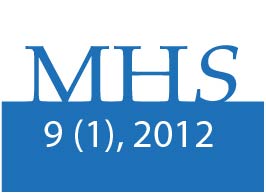Effect of the application of a multimedia in the acquisition of skills for the evaluation of physical fitness components related to health, in students of Physical Education of the National University
DOI:
https://doi.org/10.15359/mhs.9-1.3Keywords:
Educational Technologies of Information and Communication, Multimedia, Academic processes, Teacher, Physical fitness components, Protocol of physical evaluation, Learning processes, Technologies, Learning models, EvaluationAbstract
The objective of this study was determining the effect of the application of a multimedia on the acquisition of the necessary skills for the evaluation of physical fitness components related to health. Methodology: subjects: university physical education students (n=29), registered in the course Evaluation of Physical Qualities. Instruments: multimedia of battery of tests for physical evaluation related to health (subcutaneous tissue thickness, cardio respiratory capacity, flexibility, muscular strength and modified abdominal muscular resistance), software of authorship Neobook for the elaboration of electronic publications, version 5.0; software for development of academic evaluations Hot Potatoes from Half – Baked Software Inc., version 6; Adobe Premiere to capture and edit video, version Pro 1.5; Audicity for audio recording; basic program for editing text Word, SONY DCR-VX2000 video camera in format MiniDV NTSC, for video recording. Procedure: the subjects performed the first test (application of tests to evaluate components of physical fitness related to health) and had a blind assessor, and based on this pretest’s results were distributed in three treatment groups, by modality of paired scores and each group was applied a different treatment: only theory, only multimedia, and theory - multimedia. Each group received 1-hour treatment for 10 weeks and by the end of this process, the blind assessor proceeded to apply the post-test to evaluate the components of physical fitness related to health, to the 3 groups. Likewise, a focal group interview was carried out on each separate group, identifying the qualitative factors. Statistical Analysis: A mixed two-way ANOVA was used (3 treatments x 2 measures) for the quantitative analysis and the analysis of contents, and categorization for the qualitative data. Results: There was no significant interaction between measures and groups, or significant differences between groups; although a positive, non-significant tendency was observed in the mixed group (theory-multimedia), which obtained higher scores than the other groups. On the other hand, statistically significant differences were found between measures, meaning all the groups improved their scores in the second measurement. In the interview a positive criteria trend was observed regarding the use of multimedia as a reinforcement tool to improve the teaching process at the level of high education, and specifically in the area of human movement sciences and health. Discussion: In general terms, the statistical results indicate the use of a multimedia, a multimedia as assistance to a teacher and a teacher without multimedia assistance, to generate knowledge in the area of physical evaluation show no differences, and that the three types of processes may be equally successful provided the same conditions as presented in this investigation are maintained. On the other hand, results of the interview show that in general, multimedia is accepted as an element aiding to improve the teaching process in the classroom. Conclusions: multimedia works as an element serving to assist teaching processes for the transmission of technical information, allowing teachers to dedicate more time to other activities.
References
Álvarez, C y Hernández, R. (2005). Pasos adelante del determinismo educativo: Ambientes colaborativos virtuales de aprendizaje. Programa Novus – Universidad Nacional. Heredia, Costa Rica: Programa Novus.
Gándara, M. (1997). ¿Qué son los programas multimedios de aplicación educativa y como se usan? ULSA, México. Recuperado desde: http://redescolar.ilce.edu.mx/redescolar/biblioteca/articulos/pdf/S%EDntesis%20G%E1ndara.pdf.
Josemaría, C. (2001). Diseño de multimedias educativas. Criterios didácticos y selección de multimedias educativas. Buenos Aires, Argentina. Recuperado desde: www.librosenred.com.
Salinas, J. (2004). Multimedia en los procesos de enseñanza-aprendizaje: elementos de discusión. Universidad de las Islas Baleares, España. Recuperado desde: http://www.uib.es/depart/gte/edutec99.html.
Sánchez, J. (2003). Producción de aplicaciones multimedias por docentes. Universidad de Málaga, España. Revista de Medios y Educación, 21(Julio), 85-98.
Sierra, F. (2002). La Educación superior y los tipos de multimedia de interacción simbólica. Universidad de Sevilla, España. Recuperado desde: http://usuarios.trcnet.com.ar/denise/repositorio/NTICs_y_EducacionSuperior.pdf.
Downloads
Published
How to Cite
Issue
Section
License
General conditions
MHSalud: Journal in Human Movement Sciences and Health by the Universidad Nacional is cover under a Creative Commons Atribución-NoComercial-SinDerivadas 3.0 Costa Rica license.
The journal is hosted in open access repositories such as the Institutional Repository of the Universidad Nacional, the Kimuk Repository of Costa Rica and La Referencia.
The editorial source of the journal must be recognized. Use the doi identifier for this purpose.
Self-archiving policy: The journal allows the self-archiving of the articles in their peer-reviewed version, edited and approved by the Editorial Board of the Journal to be available in Open Access through the Internet. More information in the following link: https://v2.sherpa.ac.uk/id/publication/25815



















